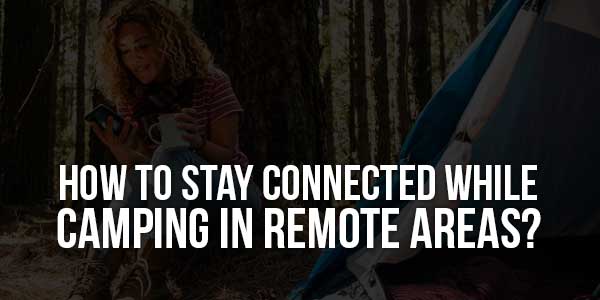
The campfire’s glowing, the stars are out, but your phone shows “No Service.” You’re miles from town, and suddenly that sense of peace turns into quiet worry. Being offline can feel more stressful than freeing, staying in touch with family, checking a weather update, or handling a work emergency.
Remote camping offers escape, but not being connected when it matters can quickly ruin the experience. The good news is you don’t have to choose between nature and connection. This guide will walk you through practical, simple ways to stay online, even off the grid, so you can explore freely without losing touch.
Table of Contents
Why Staying Connected While Camping Matters?
Let’s be real—camping is about escaping the daily grind, not the modern world entirely. Staying connected isn’t just for scrolling social media; it’s about safety, emergencies, and peace of mind. Whether you’re a weekend hiker or a full-time RVer, here’s why keeping a lifeline matters.
Safety in Emergencies:
Remote areas mean unpredictable risks—injuries, wildlife encounters, or sudden weather changes. A working phone or satellite device can be the difference between a close call and a rescue call. Even if you’re experienced, nature doesn’t always follow plans.
Keeping Loved Ones Updated:
No one wants to leave family guessing if you’re safe. A quick text or GPS check-in eases their worries (and yours). Communication avoids unnecessary panic back home if your trip gets extended or plans change.
Work or Travel Flexibility:
Digital nomads and remote workers aren’t giving up paychecks for fresh air. With the right setup, you can send emails from a lakeside view. Even weekend campers might need to check in for urgent responsibilities.
Access to Real-Time Info:
Weather alerts, trail closures, or wildfire updates aren’t luxuries—they’re essentials. Online maps can reroute you if a path is washed out. Offline downloads help, but live info is gold when conditions shift fast.
Sharing the Adventure:
Let’s not pretend we don’t want to post that sunset pic. Sharing your trip inspires others and keeps memories alive. Just balance it with being present—no one regrets looking up from their screen.
Staying connected isn’t about being glued to your phone; it’s about smart preparedness. Pack the right gear, know your options, and then relax—you’ve got backup when you need it.
Challenges of Getting Internet in Remote Camping Locations:
Getting away from the city is great—until you realise your phone has no bars. In remote camping spots, staying connected isn’t always easy. It’s not just about having a signal; it’s about all the little things that make internet access tricky. Here’s what you might run into when trying to get online in the wild.
1.) Weak or No Cell Signal:
Most remote areas have poor coverage, or none at all. You might find a single bar if you’re lucky, and even that can drop fast. Hills, trees, and distance from towers all mess with your signal. It’s frustrating when you need it most.
2.) Power Limitations:
Even if you have a hotspot or booster, it won’t work without power. Many campsites don’t have outlets. That means managing your device battery becomes part of your plan. And charging everything off a power bank only lasts so long.
3.) Data Restrictions:
Some mobile plans don’t work well in remote zones. Or you burn through your data quickly, trying to load maps or watch a quick video. It’s easy to forget how much we rely on strong, unlimited internet—until you don’t have it.
4.) Slow Speeds:
You might technically be “connected,” but everything still loads like it’s 2005. Remote towers often get overloaded or offer just enough speed for texts. Streaming or video calls? Probably not going to happen unless you’re prepared.
5.) Weather Can Mess Things Up:
Rain, storms, or heavy clouds can weaken signal strength. If you’re relying on satellite or boosters, weather interference becomes a real issue. Sometimes, even just a foggy morning slows everything down.
6.) Signal Blockage from Terrain:
Mountains, valleys, and thick forests can block or bounce signals. So even with good equipment, location matters. You might have to hike around just to find a spot with decent reception, and that’s not always ideal or safe.
Getting internet in remote camping spots isn’t always simple. It takes planning, the right gear, and knowing what to expect. Once you’re aware of the challenges, it’s easier to find the solution that works best for your trip.

How to Prepare for Connectivity Before You Go?
Nothing ruins a camping trip faster than realising you can’t call for help or check a map. A little prep goes a long way—here’s how to avoid the “oh no” moment when you lose service in the woods.
1.) Check Coverage Maps:
Don’t trust carrier ads saying “nationwide coverage.” Pull up real coverage maps (like FCC or OpenSignal) for your exact camping spot. Look for gaps where valleys or mountains might block signals completely.
2.) Download Offline Maps & Guides:
Google Maps lets you save areas offline—do this while you still have Wi-Fi. The same goes for trail maps, camping apps, and emergency info. Your future lost self will thank you.
3.) Choose the Right Data Plan:
Standard plans often fail in rural areas. Look for carriers with extended rural coverage or consider a rural internet services provider like Ubifi that focuses on off-grid connectivity. Check for throttling limits before you go.
4.) Pack Backup Power:
A single portable charger won’t cut it for week-long trips. Bring a solar charger or power station, plus extra cables. Test everything at home first—dead gear is just expensive dead weight.
5.) Set Up Emergency Contacts:
Save local ranger numbers and emergency contacts in your phone (and on paper). Enable location sharing with someone trustworthy so they can track you if needed.
6.) Test Your Gear:
Try making calls and using data with your setup at home first. You don’t want to discover your hotspot doesn’t work when you’re already 20 miles from civilisation.
Prepping for connectivity takes an hour tops, but saves days of frustration. With the right maps, gear, and a reality check on coverage, you’ll stay safer and saner in the wild. Now go enjoy those views—you’ve earned them.
Top Ways to Stay Connected While Camping:
Staying connected while camping doesn’t have to be complicated. With the right tools and a little planning, you can keep in touch, check maps, or even take a quick work call if needed. Here are the top ways to stay online, even when you’re off the beaten path.
- Use a mobile hotspot: Turn your phone into a hotspot or bring a separate device to share internet with others.
- Try a rural internet provider: Rely on services that offer reliable wireless coverage in remote areas.
- Invest in a cell signal booster: Boosters can grab weak signals and improve connection strength in low-coverage spots.
- Download offline tools and apps: Maps, weather updates, and guides can all work without internet once downloaded.
- Camp near signal zones: Look for high ground or spots close to known towers —the signal is often better there.
- Use satellite communication devices: For emergencies or longer trips, satellite messengers keep you connected even without cell service.
- Stick to power-smart habits: Turn off unused apps and devices to save battery for when you need it.
You don’t need to go fully off-grid unless you want to. With these tools and tips, you can maintain optimal internet speed and stay connected while camping. Just pick what fits your trip and comfort level best.
How to Choose the Right Internet Option for Your Trip?
Every camping trip is different. Where you’re going, how long you’ll be out, and what you need online all play a role. Choosing the right internet option isn’t about getting the best—it’s about finding what works for your trip.
- Check your destination’s signal coverage: Start by looking up which networks cover your campsite. This helps you know if a hotspot or booster will even work.
- Know your internet needs: Will you be checking emails or streaming movies? Knowing how much data you’ll need makes it easier to choose the right plan.
- Compare hotspot options: Some phones allow tethering, but dedicated hotspots offer stronger signals and better battery life for longer use.
- Consider rural internet services: Providers like UbiFi offer internet built for remote areas. It’s perfect when cell service is spotty, but you still need access.
- Look at data limits and speed: Make sure your plan or device won’t throttle you after a small amount of use. Slow internet can be more frustrating than no internet.
- Factor in your power source: If your gear needs charging, be sure you have solar panels or backup batteries. No power, no internet.
- Test everything before you go: It’s better to find a problem at home than at the campsite. Run a quick test to be sure your setup works.
Picking the right internet for your trip is all about matching it to your needs and your location. A little research up front saves you a lot of hassle out there.
Final Thoughts:
Staying connected while camping doesn’t have to be complicated. It just takes a little planning and the right tools. Knowing the challenges ahead—like spotty signals or limited power—helps you avoid last-minute stress. From checking coverage maps to picking gear that suits your needs, it all adds up to a smoother trip.
There are plenty of ways to stay online, whether it’s through mobile hotspots, signal boosters, or reliable rural internet services. And when you’re prepared, it’s easier to find that balance between enjoying nature and staying in touch. You don’t need to be fully off-grid to have a real adventure—you just need to be ready for it.

 About the Author:
About the Author:
















Be the first to write a comment.